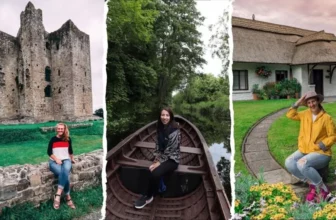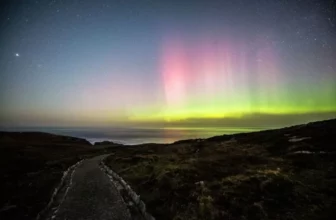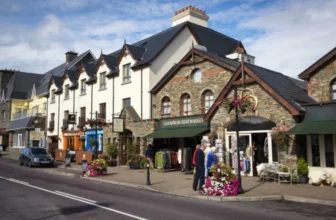Discover the Celtic Routes of West Wales and Ireland’s Ancient East and you’ll take roads less travelled to the land of the ancients. Uncover lost abbeys, sacred stones and castle ruins. Unearth the legends of saints, giants and princes.
Explore wild coastlines and rugged mountains that’ll fire your sense of adventure. And stumble across colourful villages and bustling towns where people still greet each other on the street – friend or stranger.
The Celtic Routes is a collaboration between Wales’ coastal communities of Carmarthenshire, Ceredigion and Pembrokeshire, and its counterparts across the Irish Sea, Wicklow, Wexford and Waterford.
The Celtic Routes aim to showcase these beautiful coastal counties to new visitors who will discover their wild untamed nature each with their own unique personalities, and a pace of life that still follows the pulse of the changing seasons and rhythms of the natural world.
The relationship between the two Celtic nations of Wales and Ireland has been established on the basis of an unbreakable bond formed through their shared heritage of showstopping landscapes, and centuries of ancient and mystical myths and legends.
Irish migrants who settled in Wales in the 5th century left their mark through the Ogham stones that still line the Welsh coastline today. And in return, Wales gave St Patrick to Ireland – or so they say.
The Welsh and Irish counties of the Celtic Routes act as almost mirror images of each other from across the Irish Sea, characterised by long, unspoilt beaches, lush rolling countryside and, rising up in the distance, dramatic mountain ranges.
And with so many of us desperate to pack up the car and set out on the road again now that travel restrictions have eased, the Celtic Routes of Wales and Ireland offer space, solitude and scenery in abundance, making them the perfect destination for your first post-lockdown adventure.
Feeling inspired? Here are 12 locations from across the Celtic Routes that will reignite your passion for travel and allow you to see some of the most beautiful locations in Wales.

Explore picture perfect Pendine Sands
This 11km-long stretch of sand in Carmarthenshire is celebrated for its sheer scale combined with stunning beauty. While Pendine Sands is perfect for a long walk on the beach, thrill-seekers will also find plenty of other adventures that will raise your heart rate. Land yachting offers the exhilaration of travelling at speeds of over 50km/h just inches above the sand.
Or you can take to the water on a sea kayak or stand-up paddle board. And if you like to feel your horsepower a little more literally, why not blast along the surf line on an invigorating horse ride?

Step back in time at Kidwelly Castle
Kidwelly’s Norman castle in Carmarthenshire, set on the banks of the River Gwendraeth, is one of the finest preserved castles in Wales. Look out for the arches through which rocks could be thrown onto the unsuspecting enemy army below. Kidwelly’s Kymer Canal which runs alongside the castle is the oldest in Wales, constructed in 1766. Originally built to transport coal out of the town, it’s now a wildlife haven.


A big cathedral for the littlest city
The westernmost peninsula of Pembrokeshireis home to the city and cathedral of St David’s. The resting place of Saint David, or ‘Dewi Sant’ in Welsh, patron saint of Wales, the cathedral has stood as a beacon of holiness and pilgrimage for over 800 years.
The present cathedral is built on the site of the 6th-century monastery Saint David founded to teach missionaries to spread Christianity. It’s believed one of those missionaries was St Patrick, the patron saint of Ireland, forging links between the two Celtic countries of Wales and Ireland many centuries ago.
Having survived the collapse of its tower, an earthquake and the Reformation, the cathedral continues to enthrall its visitors such is its magnificence. Its size and scale dominates the tiny yet beautiful coastal city of St Davids, which has a population of around 2,000 people. For a real treat, check out all of the best castles in Wales.


Walk the Pembrokeshire Coast Path to Strumble Head
No trip to Pembrokeshire would be complete without tackling some of the Pembrokeshire coastal path, which twists and turns for 186 miles from St Dogmaels in the north to Amroth in the south. Stop at Strumble Head, near the town of Fishguard and within the Pembrokeshire Coast National Park, with its rocky and jagged headland jutting out of the coastline.
As well as being completely stunning, it boasts incredible wildlife including bottle-nose dolphins, grey seals and even orcas have been spotted here. Bring a good pair of walking boots!
Discover the jewel in Wales’ mountain ranges
Pumlumon, meaning ‘Five Peaks’, is a ridge of peaks in the Cambrian Mountains in Ceredigion, the highest of which is Pen Pumlumon Fawr at 752m. Although it’s not the highest of Wales’ mountains, many people consider it the jewel in Wales’ crown. On a clear day at the summit, the whole of Wales unfolds before the eyes. Pumlumon is also the source of the River Severn, Britain’s longest river, as well as the Rheidiol.

Take a walk on the wild side of Devil’s Bridge
In Ceredigion, you’ll find the unique sight of three separate bridges spanning the 90m waterfalls of the River Mynach – one built on top of the other. The three individual bridges, known as Devil’s Bridge, were built between the 11th and 19th centuries and according to the legend, the original bridge was built by the Devil himself as it was considered too difficult a task for mortals. He agreed to build the bridge in exchange for the soul of the first being to cross the bridge.
However, he was outwitted by a canny old woman and banished from the country forever. Whatever story you believe, this is an ideal stop off point on your Celtic Routes road trip.

Find ancient castle ruins on Wicklow’s coast
The ruins of the Black Castle stand on a rocky headland looking out across Wicklow town and the North Wicklow coast. Built around 1176 following the Norman invasions, Black Castle is a castle with a turbulent history, consistently under frequent attack from the local chieftains.
It was burned down in both 1295 and 1315, but the castle managed to survive until around 1645, when it was attacked again and eventually demolished. Its haunting ruins are framed magnificently by the surrounding coastline and the Irish Sea.

Follow the river and discover Avoca
Two rivers, Avonmore and Avonbeg, meet about two miles from the village of Avoca in Wicklow to form the Avoca River. Follow this river for a beautiful walk, passing through the Avoca village and taking in the majesty of the stunning landscape across the valley. The area was immortalised by Irish poet Thomas Moore in ‘The Meeting of the Waters’ and Avoca was the fictional village of ‘Ballykissangel’ in the late 90s BBC series of the same name.

Visit Ireland’s smallest port
Described as Ireland’s smallest port, the diminutive Fethard Quay in Wexford is one of the oldest harbours on Ireland’s east coast that still mostly exists in its original form. Built in 1741, the harbour is just 30 meters wide and 60 meters in length, consisting of a quay and two piers.
It was never intended as a harbour for fishing boats but was purpose-built to shelter just one vessel – the King’s Barge – a revenue cruiser responsible for policing smuggling activities.

Take a whistle-stop tour of the Hook Peninsula
If you’re short on time, this one-hour drive is the ideal way to take in the main sights along the long finger of the Hook Peninsula in Wexford. Around every other bend is a quiet beach, a crumbling fortress, a stately abbey or a seafood restaurant, and at the tip of the peninsula stands the world’s oldest working lighthouse – Hook Lighthouse.

Take a pilgrimage to Admore for pure peacefulness
Beautiful Ardmore, an ancient fishing village in Waterford, has history in abundance. Visit and you’ll be transported back as far as the 5th century when its monastery, Ireland’s oldest Christian settlement in fact, was founded by St Declan. You’ll also find an 8th-century oratory and a 12th-century 29m-high round tower, which served as a belfry and place of refuge.
Make sure you find time for the 4km cliff walk that starts and ends in the village, where you’ll pass St Declan’s Well, where pilgrims have paid tribute for hundreds of years on the 24th July, the Saint’s feast day.


Check out the ornate Ballysaggartmore Towers
With their gothic style, Ballysaggartmore Towers in Waterford were the extravagant building work of Anglo Irish landlord, Arthur Keily-Ussher, in around 1834. The imposing gates were the only part of his castle to be built however, before he ran out of money. Now they stand as a passing point along woodland walks in the area near Lismore, a heritage town that boasts a significant history.


How do I get there?
Road – Your Celtic Routes adventure is accessible by car, driving along the coast of Carmarthenshire, Pembrokeshire and Ceredigion before crossing to Ireland.
Sea – After exploring Wales’ Celtic Routes offering, you can catch a ferry from Fishguard in Wales to Rosslare in Ireland.
Air – Fly direct from Cardiff, Bristol or London airports to Dublin, hire a car and then drive south to Wicklow, Wexford and Waterford.
To start planning your trip across the Celtic Routes, go to celticroutes.info for more information and inspiration and follow Celtic Routes on Facebook, Twitter and Instagram.
*As of 4th August 2024, travellers arriving to Ireland from the UK will be required to quarantine for 14 days on arrival. This is being continually reviewed. READ MORE: https://www.gov.ie/en/publication/8868e-view-the-covid-19-travel-advice-list/





